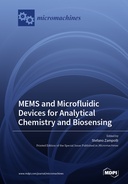Explore

MEMS and Microfluidic Devices for Analytical Chemistry and Biosensing
0 Ungluers have
Faved this Work
Login to Fave
The outbreak of the SARS-CoV-2 pandemic has made the general public aware of the breakthrough technologies which were developed in recent years for state-of-the-art biosensing, and terms such as clinical specificity and sensitivity are now widely understood. The need for reliable point-of-care diagnostic systems during the last few years has been crucial. Continuous developments in MEMS technology and microfluidics are key drivers for the miniaturization of lab-grade sensing systems. Micro-technologies and miniaturization allow for designing lightweight and small devices, other advantages include reduced consumption of power and reagents, faster response times, increased sensitivity, reduced environmental footprint, availability of batch production processes for low-cost and disposable devices. This Special Issue published seven novel contributions in the fields of biosensing, lab-on-chip, organ-on-chip and related technologies such as numerical microfluidics studies, digital micro-fluidics and micromixers.
This book is included in DOAB.
Why read this book? Have your say.
You must be logged in to comment.
Rights Information
Are you the author or publisher of this work? If so, you can claim it as yours by registering as an Unglue.it rights holder.Downloads
This work has been downloaded 64 times via unglue.it ebook links.
- 64 - pdf (CC BY) at Unglue.it.
Keywords
- Analytical Chemistry
- biosensing
- Chemical engineering
- Industrial Chemistry
- Industrial chemistry & manufacturing technologies
- lab-on-chip
- MEMS
- Microfluidics
- Technology, engineering, agriculture
- Technology: general issues
Links
DOI: 10.3390/books978-3-0365-6202-5Editions

